Related Research Articles

The history of Jordan refers to the history of the Hashemite Kingdom of Jordan and the background period of the Emirate of Transjordan under British protectorate as well as the general history of the region of Transjordan.
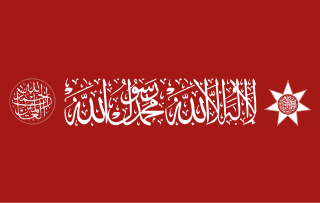
The Hashemites, also House of Hashim, are the royal family of Jordan, which they have ruled since 1921, and were the royal family of the kingdoms of Hejaz (1916–1925), Syria (1920), and Iraq (1921–1958). The family had ruled the city of Mecca continuously from the 10th century, frequently as vassals of outside powers, and ruled the thrones of the Hejaz, Syria, Iraq, and Jordan following their World War I alliance with the British Empire.
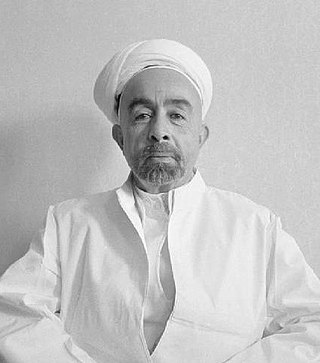
Abdullah I bin Al-Hussein was the ruler of Jordan from 11 April 1921 until his assassination in 1951. He was the Emir of Transjordan, a British protectorate, until 25 May 1946, after which he was king of an independent Jordan. As a member of the Hashemite dynasty, the royal family of Jordan since 1921, Abdullah was a 38th-generation direct descendant of Muhammad.
Faisal Akef Al-Fayez is a Jordanian politician who was the 34th Prime Minister of Jordan from 25 October 2003 to 6 March 2005. Additionally, Al-Fayez is the only person in Jordanian history who was a Prime Minister, President of the Senate, President of the House of Representatives, and Head of the Royal Hashemite Court. He took office following the resignation of Ali Abu al-Ragheb. He previously served as Minister of Defense and is very close to King Abdullah II.

Hussein bin Ali al-Hashimi was an Arab leader from the Banu Qatadah branch of the Banu Hashim clan who was the Sharif and Emir of Mecca from 1908 and, after proclaiming the Great Arab Revolt against the Ottoman Empire, King of the Hejaz, even if he refused this title, from 1916 to 1924. He proclaimed himself Caliph after the abolition of the Ottoman Caliphate in 1924 and stayed in power until 1925 when Hejaz was invaded by the Saudis. His Caliphate was opposed by the British and French Empires, the Zionists and the Wahhabis alike. However, he received support from a large part of the Muslim population of that time and from Mehmed VI. He is usually considered as the father of modern pan-Arabism.

The Arab Revolt, also known as the Great Arab Revolt, was an armed uprising by the Hashemite-led Arabs of the Hejaz against the Ottoman Empire amidst the Middle Eastern theatre of World War I.

The tribe of Shammar is a tribal Arab Qahtanite confederation, descended from the Tayy, which migrated into the northern Arabian Peninsula from Yemen in the second century. It is the largest branch of the Tayy, and one of the largest and most influential Arab tribes. The historical and traditional seat of the tribe's leadership is in the city of Ḥaʼil in what was the Emirate of Jabal Shammar in what is now Saudi Arabia. In its "golden age", around 1850, the Shammar ruled much of central and northern Arabia from Riyadh to the frontiers of Syria and the vast area of Upper Mesopotamia.
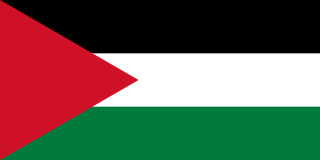
The Hashemite Arab Federation was a short-lived confederation that lasted from 14 February to 2 August 1958, between the Hashemite kingdoms of Iraq and Jordan. Although the name implies a federal structure, it was de facto a confederation.

The Beni Sakhar confederacy is one of the largest and most influential tribal confederacies in both Lebanon and Jordan. Its founder, Sakher bin Tha'labah al Tayy, likely lived in the 3rd century AD, making the tribe around 18 centuries old. The Bani Sakher began migrating to The Levant as early as the 16th century and grew to become an influential tribe as by around the mid 18th century.

The Sharifian Army, also known as the Arab Army, or the Hejazi Army was the military force behind the Arab Revolt which was a part of the Middle Eastern theatre of World War I. Sharif Hussein Ibn Ali of the Kingdom of Hejaz, who was proclaimed "Sultan of the Arabs" in 1916, led the Sharifian Army in a rebellion against the Ottoman Empire with the ultimate goal of uniting the Arab people under an independent government. Aided both financially and militarily by the British, Husayn's forces gradually moved north through the Hejaz and, fought alongside the British-controlled Egyptian Expeditionary Force, eventually capturing Damascus. Once there, members of the Sharifian Army set up a short-lived monarchy known as the Arab Kingdom of Syria led by Faisal, a son of Sharif Husayn.
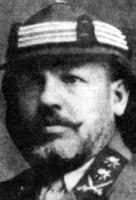
Ali Rida al-Rikabi was the First Prime Minister in modern Syria and was also the 3rd Prime Minister of Jordan.

Aliya bint Ali of Hejaz, was an Arabian princess and a queen consort of Iraq. She was the spouse and first cousin of King Ghazi of Iraq and the queen mother of King Faisal II of Iraq. She was the second and last Queen of Iraq.

The Ikhwan raids on Transjordan were a series of attacks by the Ikhwan, irregular Arab tribesmen of Najd, on the Emirate of Transjordan between 1922 and 1924. The repeated Wahhabi incursions from Najd into southern parts of his territory were the most serious threat to Emir Abdullah I's position in Transjordan. The emir was powerless to repel these raids by himself, thus the British maintained a military base, with a small air force, at Marka, close to Amman. The British military force was the primary obstacle against the Ikhwan, and ultimately helped Abdullah to secure his rule over Transjordan.
The Adwan Rebellion or the Balqa Revolt was the largest uprising against the newly established Transjordanian government, headed by Mezhar Ruslan, during its first years.
This is a timeline of major events in the history of the modern state of Jordan.
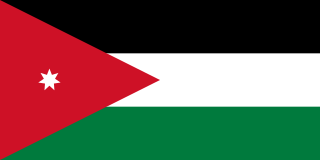
Jordanian nationalism is a nationalistic ideology that considers the Jordanian people a separate nation and strives to maintain Jordan as an independent nation-state. It emerged as one of three nationalist currents in the 1920s, and was opposed to both Palestinian nationalism present in the region, as well as the Hashemite Arab nationalism promoted by Abdullah I, the first ruler of the Emirate of Transjordan.
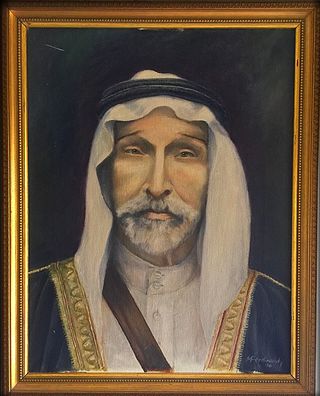
Haditha Ali Abdullah Al-Khraisha was a Jordanian Bedouin tribal leader. He was one of the two paramount sheikhs of the Bani Sakhr Tribe, arguably the most powerful tribe in Jordan. Haditha headed the northern clans of the Bani Sakher (al-Ka'abnah), while Mithgal Al-Fayez headed the other half, (al-Twaga). In the early twentieth century, Haditha and the Bani Sakhr, in addition to other Trans-Jordanian tribes such as the Huweitat and the Belqawiah, fought the Wahhabi Ikhwan, a religious militia who helped establish Abdul Aziz Ibn Saud as the first King of Saudi Arabia. The Wahhabi Ikhwan were Abdul Aziz Ibn Saud's tool for territorial expansion and lent religious legitimacy to Ibn Saud's territorial and political ambitions. According to King Faisal Al Saud the armed resistance that Bani Sakhr put up against Ibn Saud and the Wahhabi Ikhwan was "the reason that Saudi Arabia's borders do not extend all the way to Palestine and why the Al Sauds never became the rulers of the Levant". Haditha was known throughout Arabia for his wisdom and chivalry, He played a significant role in building the nascent Jordanian state and shaping its development. An ally and supporter of King Abdullah I, Haditha served several terms as Senator and Parliamentarian, including the first Jordanian Senate in 1947 which consisted of only ten members. Haditha was also elected to the second Legislative Council in June 1931, and the Fourth Legislative Council in 1937 while Jordan was still an Emirate. Haditha was also one of the founding members of the Jordanian Solidarity Party in March 1933. Sheikh Haditha also cultivated the oasis of Azraq, Jordan.
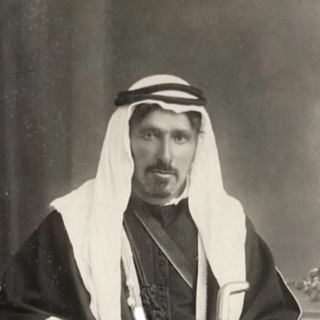
Mithqal bin Sattam bin Fendi Al-Fayez (Arabic: مثقال الفايز, was a Jordanian political and tribal figure whose work helped the establishment of The Hashemite Kingdom of Jordan. Mithqal was one of the two leading sheikhs of Bani Sakhr; he took power in the early twentieth century, and headed the Bani Sakhr tribe generally and the Al-Twaga half of the tribe specifically, which consisted of the four major clans, Al Ghbeyen, Al Ghuful, Al A'lqam, and Al Tabtab, which comprise 32 sub-clans which further divide into more sub-clans. He also headed his own clan, Al-Fayez.

Establishment of the Emirate of Transjordan refers to the government that was set up in Transjordan on 11 April 1921, following a brief interregnum period.
The House of Fayez(Arabic: الفايز or, colloquially: Al-Fayez, Alfayez, Al Fayez, Al Faiz, Al Fayiz) is a noble sheikhly Jordanian family that heads the major Jordanian clan Bani Sakher. The family's influence and prominence in the region was at its ultimate under Fendi Al-Fayez, who led the family in the 1840s and gradually became the leader of the entire Bani Sakher. Fendi would rule large parts of Jordan and Palestine, including the ancient Kingdoms of Moab and Ammon, and parts of modern-day Saudi Arabia until the late 1860s when a series of battles with the Ottoman Empire decreased the family's resources and claimed a portion of its holdings. After Fendi, his young son Sattam led the tribe in a push to cultivate the lands and live a more sedentary lifestyle, then under Mithqal Alfayez as a permanent political power in modern Jordan. The family was the largest owner of land in Jordan and owned portions of modern day Palestine, and Mithqal was the single largest owner of private land in the kingdom in 1922. The Al-Fayez family is active in Jordanian and Arabian politics and is currently headed by former Prime Minister Faisal Al-Fayez.
References
- ↑ Jehl, Douglas (1999-06-20). "FOR SHAME: A special report; Arab Honor's Price: A Woman's Blood". New York Times. Archived from the original on 17 April 2009. Retrieved 2009-03-29.
- 1 2 3 George, Alan (2005). Jordan: Living in the Crossfire. London: Zed Books. pp. 93–102. ISBN 978-1-84277-471-7 . Retrieved 2009-01-20.
- ↑ George, Alan (2005). Jordan: Living in the Crossfire. 7 Cynthia Street, London, N1 9JF, UK: Zed Books. pp. 93–94. ISBN 9781842774717.
{{cite book}}: CS1 maint: location (link) - ↑ Wilson, Rodney (1991). Politics and the Economy in Jordan. Routledge. pp. 158–159. ISBN 978-0-415-05304-4 . Retrieved 2009-03-27.